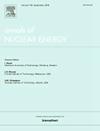Autonomous anomaly detection of proliferation in the AGN-201 nuclear reactor digital twin
IF 1.9
3区 工程技术
Q1 NUCLEAR SCIENCE & TECHNOLOGY
引用次数: 0
Abstract
The expansion of global nuclear power necessitates advanced methods for analyzing proliferation indicators. This study introduces a novel application of the Isolation Forest Machine Learning (IFML) algorithm within a digital twin (DT) of the AGN-201 nuclear reactor to autonomously detect anomalies. Leveraging real-time operational data from the AGN-201 DT, the IFML algorithm identifies outliers without prior data labeling and operates as a lightweight, complementary approach to traditional physics-based anomaly detection methods for nuclear safeguards. In a simulated Red vs. Blue team exercise, the IFML algorithm successfully detected six significant unseen anomalies related to reactivity changes, achieving an accuracy of 99% for identifying operational deviationxs. These anomalies, caused by deliberate perturbations, were detected alongside known physics-based models, underscoring the potential of IFML to enhance real-time monitoring without displacing traditional methods. This study highlights the applicability of IFML in nuclear environments by providing an additional, redundant layer of anomaly detection to improve safeguards and operational safety in complex systems.
求助全文
约1分钟内获得全文
求助全文
来源期刊

Annals of Nuclear Energy
工程技术-核科学技术
CiteScore
4.30
自引率
21.10%
发文量
632
审稿时长
7.3 months
期刊介绍:
Annals of Nuclear Energy provides an international medium for the communication of original research, ideas and developments in all areas of the field of nuclear energy science and technology. Its scope embraces nuclear fuel reserves, fuel cycles and cost, materials, processing, system and component technology (fission only), design and optimization, direct conversion of nuclear energy sources, environmental control, reactor physics, heat transfer and fluid dynamics, structural analysis, fuel management, future developments, nuclear fuel and safety, nuclear aerosol, neutron physics, computer technology (both software and hardware), risk assessment, radioactive waste disposal and reactor thermal hydraulics. Papers submitted to Annals need to demonstrate a clear link to nuclear power generation/nuclear engineering. Papers which deal with pure nuclear physics, pure health physics, imaging, or attenuation and shielding properties of concretes and various geological materials are not within the scope of the journal. Also, papers that deal with policy or economics are not within the scope of the journal.
 求助内容:
求助内容: 应助结果提醒方式:
应助结果提醒方式:


